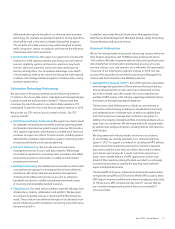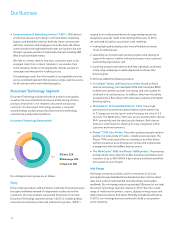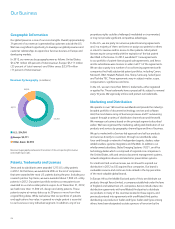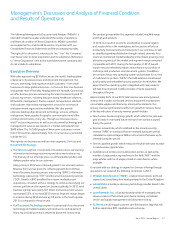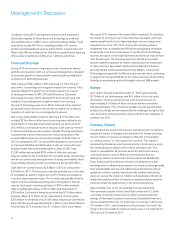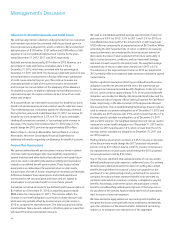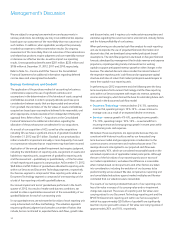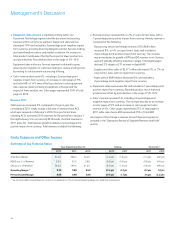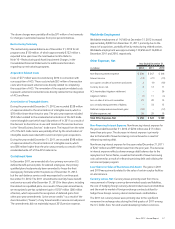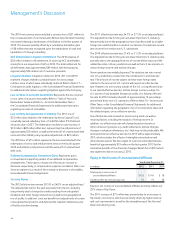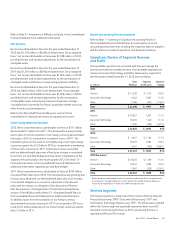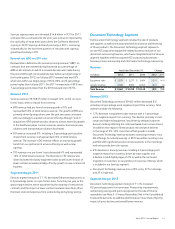Xerox 2012 Annual Report Download - page 33
Download and view the complete annual report
Please find page 33 of the 2012 Xerox annual report below. You can navigate through the pages in the report by either clicking on the pages listed below, or by using the keyword search tool below to find specific information within the annual report.
31Xerox 2012 Annual Report
Benefit plan costs are included in several income statement
components based on the related underlying employee costs.
(in millions) Estimated Actual
Benefit Plan Funding: 2013 2012 2011 2010
Defined benefit pension plans:
Cash $ 195 $ 364 $ 426 $ 237
Stock – 130 130 –
Total 195 494 556 237
Defined contribution plans 113 63 66 51
Retiree health benefit plans 80 84 73 92
Total Benefit Plan Funding $ 388 $ 641 $ 695 $ 380
The decrease in required contributions to our worldwide defined
benefit pension plans is largely in the U.S. and reflects the expected
benefits from the pension funding legislation enacted in the U.S.
during 2012. This decrease is partially offset by an expected increase in
contributions to our defined contribution plans.
Refer to Note 15 – Employee Benefit Plans in the Consolidated
Financial Statements for additional information regarding expense
and funding.
Income Taxes
We record the estimated future tax effects of temporary differences
between the tax bases of assets and liabilities and amounts reported
in our Consolidated Balance Sheets, as well as operating loss and tax
credit carryforwards. We follow very specific and detailed guidelines
in each tax jurisdiction regarding the recoverability of any tax assets
recorded in our Consolidated Balance Sheets and provide valuation
allowances as required. We regularly review our deferred tax assets
for recoverability considering historical profitability, projected future
taxable income, the expected timing of the reversals of existing
temporary differences and tax planning strategies. Adjustments to our
valuation allowance, through (credits) charges to income tax expense,
were $(9) million, $(5) million and $22 million for the years ended
December 31, 2012, 2011 and 2010, respectively. There were other
(decreases) increases to our valuation allowance, including the effects
of currency, of $(14) million, $(53) million and $11 million for the years
ended December 31, 2012, 2011 and 2010, respectively. These did
not affect income tax expense in total as there was a corresponding
adjustment to deferred tax assets or other comprehensive income.
Gross deferred tax assets of $3.8 billion and $3.8 billion had valuation
allowances of $654 million and $677 million at December 31, 2012
and 2011, respectively.
unamortized net actuarial losses upon settlement. As noted above,
cumulative unamortized net actuarial losses were $3.4 billion at
December 31, 2012, of which the U.S. primary domestic plans
represented $1.1 billion. The pro rata factor is computed as the
percentage reduction in the projected benefit obligation due to the
settlement of a participant’s vested benefit. Settlement accounting
is only applied when the event of settlement occurs – i.e. the lump-
sum payment is made or the annuity purchased. Since settlement
is dependent on an employee’s decision and election, the level of
settlements and the associated losses can fluctuate significantly period
to period. In 2012, settlement losses associated with our primary
domestic pension plans amounted to $82 million and were $16 million,
$14 million, $24 million and $28 million for the first through fourth
quarters of 2012, respectively. Currently, on average, approximately
$100 million of plan settlements will result in settlement losses of
approximately $24 million. During the three years ended December
31, 2012, U.S. plan settlements were $481 million, $598 million and
$393 million, respectively.
Refer to Note 15 – Employee Benefit Plans in the Consolidated
Financial Statements for additional information regarding our defined
benefit pension plan assumptions.
The following is a summary of our benefit plan costs and funding
for the three years ended December 31, 2012 as well as estimated
amounts for 2013:
(in millions) Estimated Actual
Benefit Plan Costs: 2013 2012 2011 2010
Defined benefit pension plans (1) $ 202 $ 300 $ 284 $ 304
Curtailment gain (2) – – (107) –
Defined contribution plans 113 63 66 51
Retiree health benefit plans 3 11 14 32
Total Benefit Plan Expense $ 318 $ 374 $ 257 $ 387
(1) Estimated 2013 assumes settlement losses are consistent with 2012.
(2) Refer to the “Plan Amendment” section in Note 15 – Employee Benefit Plans in the
Consolidated Financial Statements for further information.
Our estimated 2013 defined benefit pension plan cost is expected
to be approximately $100 million lower than 2012, primarily driven
by the U.S. defined benefit plan freeze at December 31, 2012,
which eliminated approximately $100 million of service costs and
reduced the amortization of actuarial losses by $47 million. These
impacts were partially offset by the worldwide 80 bps decrease in the
discount rate. Offsetting the decrease in our defined benefit pension
plan expense is an increase in expense associated with our defined
contribution plans as employees from those defined benefit pension
plans that have been amended to freeze future service accruals are
transitioned to enhanced defined contribution plans.


